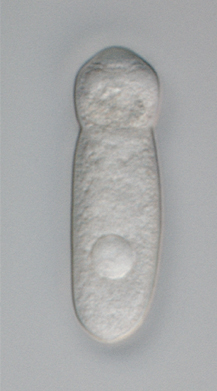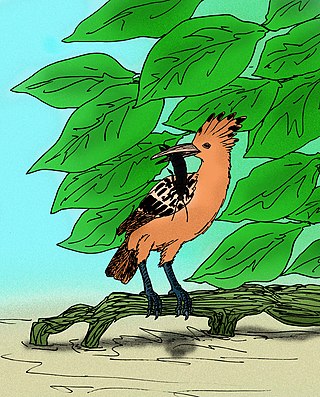
Hoopoes are colourful birds found across Africa, Asia, and Europe, notable for their distinctive "crown" of feathers. Three living and one extinct species are recognized, though for many years all of the extant species were lumped as a single species—Upupa epops. In fact, some taxonomists still consider all three species conspecific. Some authorities also keep the African and Eurasian hoopoe together but split the Madagascar hoopoe. The Eurasian hoopoe is common in its range and has a large population, so it is evaluated as Least Concern on The IUCN Red List of Threatened Species. However, their numbers are declining in Western Europe. Conversely, the hoopoe has been increasing in numbers at the tip of the South Sinai, Sharm el-Sheikh. There are dozens of nesting pairs that remain resident all year round.

Plasmodium is a genus of unicellular eukaryotes that are obligate parasites of vertebrates and insects. The life cycles of Plasmodium species involve development in a blood-feeding insect host which then injects parasites into a vertebrate host during a blood meal. Parasites grow within a vertebrate body tissue before entering the bloodstream to infect red blood cells. The ensuing destruction of host red blood cells can result in malaria. During this infection, some parasites are picked up by a blood-feeding insect, continuing the life cycle.

The gregarines are a group of Apicomplexan alveolates, classified as the Gregarinasina or Gregarinia. The large parasites inhabit the intestines of many invertebrates. They are not found in any vertebrates. Gregarines are closely related to both Toxoplasma and Plasmodium, which cause toxoplasmosis and malaria, respectively. Both protists use protein complexes similar to those that are formed by the gregarines for gliding motility and for invading target cells. This makes the gregarines excellent models for studying gliding motility, with the goal of developing treatment options for both toxoplasmosis and malaria. Thousands of different species of gregarine are expected to be found in insects, and 99% of these gregarine species still need to be described. Each insect species can be the host of multiple gregarine species. One of the most-studied gregarines is Gregarina garnhami. In general, gregarines are regarded as a very successful group of parasites, as their hosts are distributed over the entire planet.

Bucerotiformes is an order of birds that contains the hornbills, ground hornbills, hoopoes and wood hoopoes. These birds were previously classified as members of Coraciiformes. The clade is distributed in Africa, Asia, Europe and Melanesia.

The Saint Helena hoopoe, also known as the Saint Helena giant hoopoe or giant hoopoe, is an extinct species of hoopoe known exclusively from an incomplete subfossil skeleton. Once endemic to the island of Saint Helena, it was last seen around 1550, likely driven to extinction by various aspects of human activity.
Plasmodium aegyptensis is a parasite of the genus Plasmodium subgenus Vinckeia which infects the Egyptian grass rat. The insect vector(s) for this species is not yet known.
Plasmodium paranucleophilum is a parasite of the genus Plasmodium subgenus Novyella. As in all Plasmodium species, P. paranucleophilum has both vertebrate and insect hosts. The vertebrate hosts for this parasite are birds.
Plasmodium brumpti is a parasite of the genus Plasmodium subgenus Sauramoeba. As in all Plasmodium species, P. brumpti has both vertebrate and insect hosts. The vertebrate hosts for this parasite are reptiles.
Plasmodium booliati is a parasite of the genus Plasmodium subgenus Vinckeia. As in all Plasmodium species, P. booliati has both vertebrate and insect hosts. The vertebrate hosts for this parasite are mammals.
Plasmodium durae is a parasite of the genus Plasmodium subgenus Giovannolaia.
Plasmodium eylesi is a parasite of the genus Plasmodium subgenus Plasmodium.
Plasmodium fischeri is a parasite of the genus Plasmodium subgenus Lacertamoeba.
Plasmodium wenyoni is a parasite of the genus Plasmodium. As in all Plasmodium species, P. wenyoni has both vertebrate and insect hosts. The vertebrate hosts for this parasite are reptiles.
Plasmodium hegneri is a parasite of the genus Plasmodium subgenus Papernaia.
Plasmodium polare is a parasite of the genus Plasmodium subgenus Papernaia.
Plasmodium guyannense is a parasite of the genus Plasmodium subgenus Sauramoeba. As in all Plasmodium species, P. guyannense has both vertebrate and insect hosts. The vertebrate hosts for this parasite are reptiles.

The Madagascar hoopoe is a species of hoopoe in the family Upupidae. It was previously considered a subspecies of the hoopoe, but was split due to its vocalisations and small differences in plumage. Some taxonomists still consider all three species conspecific. Some authorities also keep the African and Eurasian hoopoe together, but split the Madagascar hoopoe. It is endemic to Madagascar, where its natural habitat is subtropical or tropical dry forest. It is a common bird and the International Union for Conservation of Nature considers its conservation status to be of least concern.
Plasmodium vinckei is a parasite of the genus Plasmodium subgenus Vinckeia. As in all Plasmodium species, P. vinckei has both vertebrate and insect hosts. The vertebrate hosts for this parasite are rodents.

The African hoopoe is a species of hoopoe in the family Upupidae. Previously considered as a subspecies of the Eurasian hoopoe, it is a resident species of southern Africa.

The Eurasian hoopoe is the most widespread species of the genus Upupa. It is a distinctive cinnamon coloured bird with black and white wings, a tall erectile crest, a broad white band across a black tail, and a long narrow downcurved bill. Its call is a soft "oop-oop-oop".







